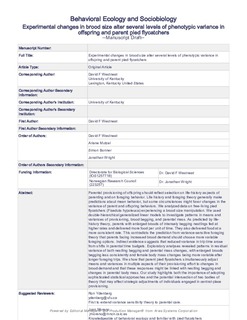| dc.contributor.author | Westneat, David F. | |
| dc.contributor.author | Mutzel, Ariane | |
| dc.contributor.author | Bonner, Simon | |
| dc.contributor.author | Wright, Jonathan | |
| dc.date.accessioned | 2017-12-01T12:54:08Z | |
| dc.date.available | 2017-12-01T12:54:08Z | |
| dc.date.created | 2017-10-19T12:57:52Z | |
| dc.date.issued | 2017 | |
| dc.identifier.issn | 0340-5443 | |
| dc.identifier.uri | http://hdl.handle.net/11250/2468787 | |
| dc.description.abstract | Parental provisioning of offspring should reflect selection on life history aspects of parenting and on foraging behavior. Life history and foraging theory generally make predictions about mean behavior, but some circumstances might favor changes in the variance of parent and offspring behaviors. We analyzed data on free-living pied flycatchers (Ficedula hypoleuca) experiencing a brood size manipulation. We used double hierarchical generalized linear models to investigate patterns in means and variances of provisioning, brood begging, and parental mass. As predicted by life history theory, parents with enlarged broods of intensely begging nestlings fed at higher rates and delivered more food per unit of time. They also delivered food at a more consistent rate. This contradicts the prediction from variance-sensitive foraging theory that parents facing higher brood demand should choose more variable foraging options. Indirect evidence suggests that reduced variance in trip time arose from shifts in parental time budgets. Exploratory analyses revealed patterns in residual variance of both nestling begging and parental mass changes, with enlarged broods begging less consistently and female body mass changes being more variable after longer foraging trips. We show that parent pied flycatchers simultaneously adjust means and variances in multiple aspects of their provisioning effort to changes in brood demand and that these responses might be linked with nestling begging and changes in parental body mass. Our study highlights both the importance of adopting sophisticated statistical approaches and the potential intersection of two bodies of theory that may affect strategic adjustments of individuals engaged in central place provisioning. | nb_NO |
| dc.language.iso | eng | nb_NO |
| dc.publisher | Springer Verlag | nb_NO |
| dc.title | Experimental manipulation of brood size affects several levels of phenotypic variance in offspring and parent pied flycatchers | nb_NO |
| dc.type | Journal article | nb_NO |
| dc.type | Peer reviewed | nb_NO |
| dc.description.version | submittedVersion | nb_NO |
| dc.source.volume | 71 | nb_NO |
| dc.source.journal | Behavioral Ecology and Sociobiology | nb_NO |
| dc.source.issue | 6 | nb_NO |
| dc.identifier.doi | 10.1007/s00265-017-2315-3 | |
| dc.identifier.cristin | 1505922 | |
| dc.relation.project | Norges forskningsråd: 223257 | nb_NO |
| dc.description.localcode | This is a submitted manuscript of an article published by Springer in Behavioral Ecology and Sociobiology, 15 May 2017 | nb_NO |
| cristin.unitcode | 194,66,10,0 | |
| cristin.unitname | Institutt for biologi | |
| cristin.ispublished | true | |
| cristin.fulltext | preprint | |
| cristin.qualitycode | 1 | |
